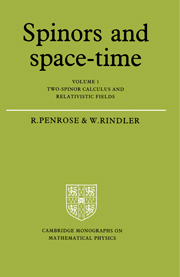Preface
Published online by Cambridge University Press: 03 February 2010
Summary
To a very high degree of accuracy, the space-time we inhabit can be taken to be a smooth four-dimensional manifold, endowed with the smooth Lorentzian metric of Einstein's special or general relativity. The formalism most commonly used for the mathematical treatment of manifolds and their metrics is, of course, the tensor calculus (or such essentially equivalent alternatives as Cartan's calculus of moving frames). But in the specific case of four dimensions and Lorentzian metric there happens to exist – by accident or providence – another formalism which is in many ways more appropriate, and that is the formalism of 2-spinors. Yet 2-spinor calculus is still comparatively unfamiliar even now – some seventy years after Cartan first introduced the general spinor concept, and over fifty years since Dirac, in his equation for the electron, revealed a fundamentally important role for spinors in relativistic physics and van der Waerden provided the basic 2-spinor algebra and notation.
The present work was written in the hope of giving greater currency to these ideas. We develop the 2-spinor calculus in considerable detail, assuming no prior knowledge of the subject, and show how it may be viewed either as a useful supplement or as a practical alternative to the more familiar world-tensor calculus. We shall concentrate, here, entirely on 2-spinors, rather than the 4-spinors that have become the more familiar tools of theoretical physicists. The reason for this is that only with 2- spinors does one obtain a practical alternative to the standard vector – tensor calculus, 2-spinors being the more primitive elements out of which 4-spinors (as well as world-tensors) can be readily built.
- Type
- Chapter
- Information
- Spinors and Space-Time , pp. vii - xPublisher: Cambridge University PressPrint publication year: 1984

